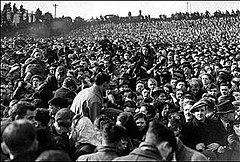Burnden Park disaster

Women and children being passed over the heads of others at the Railway End during the crush
|
|
| Date | 9 March 1946 |
|---|---|
| Location | Burnden Park, Bolton, Lancashire, England, UK |
| Cause | Overcrowding of banking terraces causing a stampede |
| Deaths | 33 |
| Non-fatal injuries | ca. 400 |
The Burnden Park disaster was a human crush that occurred on 9 March 1946 at Burnden Park football stadium, then the home of Bolton Wanderers. The crush resulted in the deaths of 33 people and injuries to hundreds of Bolton fans. It was the deadliest stadium-related disaster in British history until the Ibrox Park disaster in 1971.
The match, an FA Cup Sixth Round second-leg tie between Bolton and Stoke City, was allowed to continue, with the game ending goalless. The disaster brought about the Moelwyn Hughes report, which recommended more rigorous control of crowd sizes.
It was estimated that the crowd was in excess of 85,000 people. Entrance to the Bolton end of the ground, which had no roof, was from the Manchester Road end only. The disaster happened at the Railway End of the ground where, in common with many other post-war grounds, facilities were rudimentary. The bank was crude, just dirt with odd flagstones for steps. Although there was room towards the Burnden side of the ground, part of the stand had been requisitioned by the Ministry of Supply and it had not yet been returned to normal use following the war. In addition, the turnstiles at the east end of the Railway Embankment which adjoined the Burnden Stand had been closed since 1940.
At the time, fans paid at the turnstiles rather than buy tickets beforehand. As a result, the end became packed and over capacity and it was decided to close the turnstiles at 2:40 pm. This, however, did not stop more people entering the ground, with people climbing in from the railway, climbing over the closed turnstiles and, when a locked gate was opened, entering through it. During the melee and such was the pressure from the railway end, that many fans were inexorably pushed along the side of the pitch, around the far end and eventually right out of the ground, ending up in the car park unable to watch the game.
Shortly after the game started, the crowd began spilling onto the pitch and the game was temporarily stopped as the pitch was cleared. However, at this time, two barriers collapsed and the crowd fell forward, crushing those underneath. The game was restarted but was quickly halted again when a police officer came onto the pitch to speak to the referee, George Dutton, to inform him there had been a fatality. He, in turn, called the two captains, Bolton's Harry Hubbick and Stoke's Neil Franklin, together to inform them and the players left the pitch.
...
Wikipedia
